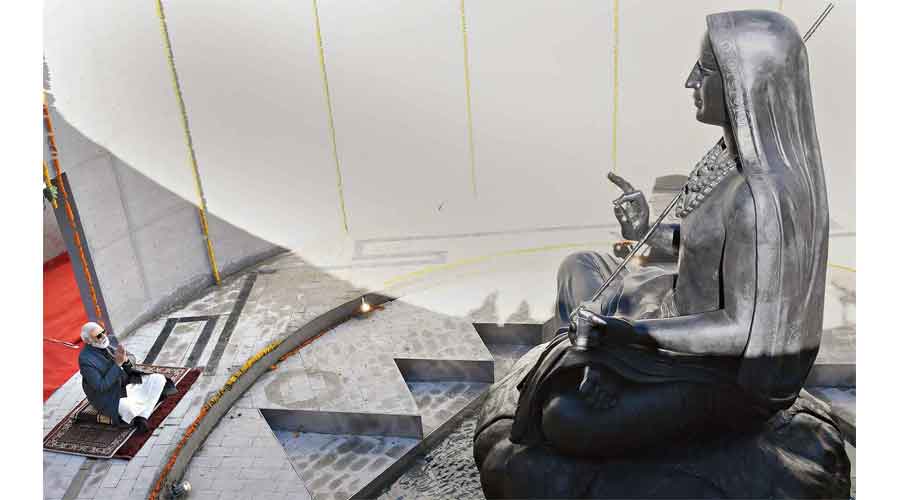Prime Minister Narendra Modi on Friday urged Indians to visit “sacred places”, naming shrines and spiritual leaders from only one religion and saying they had “kept our faith together” and protected it “during the period of slavery”.
“I request my countrymen that besides going to see the historic sites related to the freedom struggle, go also to the sacred places in large numbers,” Modi said during a visit to the famed Kedarnath temple in poll-bound Uttarakhand.
“Friends, there’s a tradition in our country to worship the Jyotirlingas (major Shiva temples), Shakti Peeths, (Siddhi) Asht-Vinayak (Ganesh). It’s considered a part of our life…. This pilgrimage is not a mere visit… it’s a lively tradition of uniting Bharat.”
He added: “Take the new generation along and introduce them to these places. You must see Ma Bharati (Mother India), feel the great tradition of the awakening of thousands of years.”
The Prime Minister prayed at the temple, unveiled a 12ft statue to eighth-century philosopher Adi Shankaracharya, and meditated for about 10 minutes in front of the statue.
During his 52-minute speech, he said that during the countrywide pilgrimage he was advocating, people should “invoke Shankara in every nook and cranny, every element of Hindustan — it’s the time to go out”.
Modi saluted those who had protected “religion” and held up Swami Vivekananda as one of them.
“It’s no mean service that they kept our faith together and didn’t allow anybody to hurt it during the period of slavery. Isn’t it the duty of every Hindustani citizen to worship those who were doing great sadhana during the period of slavery?” he said.
Modi said: “This is why I’m saying that as citizens, we should visit these sacred places to pay homage. We should know the glory of these sacred places.”
He lauded Uttarakhand, where Assembly polls are due by March, as a “sacred land” and promised development.
“The people of Uttarakhand must note down my words and hold on to them. I’m saying this from the sacred land,” Modi said.
“The way infrastructure is developing here, more work will be done in 10 years than in the last 100 years. This decade of the 21st century belongs to Uttarakhand.”
Modi said similar development was going on in the religious towns of Uttar Pradesh and named only Hindu sites: Varanasi, his parliamentary constituency, Ayodhya, where a Ram temple is coming up, and Mathura, considered the birthplace of Krishna.
Sanctum TV
While the usual publicity blitz accompanied Modi’s visit, this was the first time TV crews entered the sanctum sanctorum to film him.
This prompted former Congress chief minister Harish Rawat to accuse the Prime Minister of conducting “a political tour to broadcast his election campaign in the name of Baba Kedarnath”.
“Much against tradition, there were camerapersons recording his event in the sanctum sanctorum. Modi did his marketing; he doesn’t know that Lord Shiva doesn’t accept any arrogance,” Rawat said.
Modi told the gathering that a large number of religious leaders and monks from key shrines across India, including the 12 Jyotirlingas, were watching the event virtually. Uttar Pradesh chief minister Yogi Adityanath too watched the programme from his Gorakhnath temple.
Uttarakhand chief minister Pushkar Singh Dhami was in Kedarnath with Modi and dubbed him “the most popular leader of the world”.
The Congress organised jalabhishek at several shrines in protest against the state’s BJP government forming a Devasthanam Board to manage all the major temples in Uttarakhand. Priests from many temples are opposed to the idea too.
Modi inaugurated a rest house for priests, a hospital, a road, a bridge and a few other development projects. He claimed he had been working for the country’s development to set deadlines but some people still doubted him.
“Whatever Modi dedicated to the nation today was started by my government,” said Rawat, who headed the state government between 2014 and 2017, his tenure punctuated by spells of central rule.
Let's compare croc notes
The great philosopher, whose home state Kerala specialises in denying electoral nirvana to the BJP, and the Prime Minister, who professes devotion to asceticism and sports carefully chosen accessories, share an uncommon bond made possible by an unlikely creature: the crocodile. Legend has it that little Shankara was drawn to sanyasa but his mother demurred. One day, while the child was bathing in a river, a crocodile caught hold of him by a leg and started dragging him away. Shankara cried out to his mother that if she permitted him to become a sanyasi, he would be saved. She relents and the crocodile frees him. Kalady, the Advaita Vedanta exponent’s birthplace in Kerala, has a Crocodile Ghat that is a pilgrim and tourist attraction.
Comic-strip legend has it that Bal Narendra (the little Modi) once jumped into a crocodile-infested lake to retrieve a ball. He collected a baby crocodile, too, and took it home but, on his mother’s advice, the hapless hatchling was taken back to the lake and freed. The lad also used to
swim to the middle of the lake (rippling with 29 crocodiles, says a book that attributes the information to villagers) to touch the flag of a temple standing in the water. One day, a crocodile's lashing tail caught Bal Narendra's left foot, wounding him badly. The injury marks are still visible, according to the book. Unlike that of the baby reptile, the fate of the ill-mannered crocodile is not known.










